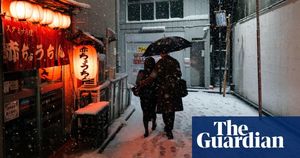At this year’s Sundance Film Festival, conversations often revolved around the devastating fires affecting the Los Angeles film community, coupled with growing concerns about the festival's future location. A campaign called “Keep Sundance in Utah” was actively underway, fueled by the announcement of potential relocations slated for 2027. The festival, which has called Park City, Utah, home for nearly 40 years, is considering Salt Lake City, Boulder, Colorado, and Cincinnati, Ohio, for its new venue as its lease expires.
While many festival attendees expressed desire for Sundance to remain where it has flourished, there's much to appreciate about the festival’s offerings this year. Even if the focus shifted to Salt Lake City, Park City could still host some select events. Nevertheless, critics point out the growing overcrowding crisis. The 11-day festival attracts over 20,000 attendees annually, illuminating the challenges facing the small town of just over 8,000 residents. With skyrocketing prices for accommodations and food, and congested streets, the question on many minds is how the festival will address its growing pains.
This year’s awards were announced, with the U.S. Dramatic Grand Jury Prize going to Hailey Gates' war satire, Atropia, and the U.S. Documentary Grand Jury Prize awarded to Brittany Shyne's Seeds, spotlighting Black farm workers from the South. These accolades reaffirm Sundance’s position as the launchpad for significant indie cinema. The festival this year unveiled films grappling with pertinent themes, attracting both established stars and up-and-coming talent. Stars like Sarah Jessica Parker, Desmond Chiam, Olivia Colman, and Benedict Cumberbatch graced the screens and red carpets.
But beyond the films, the festival’s very future lies uncertain. The discussions surrounding potential relocation stem from the increasing expenses and logistical nightmares for its current host city. The cost of living during Sundance has surged dramatically; reports indicate $500 per night accommodations are considered bargains. This year, festival-goers expressed frustration with long shuttle bus rides from Main Street to the Eccles Theater, often taking over an hour. Amid price hikes, the atmosphere of excitement is tempered by the realities of running such a celebrated event.
While theater troubleshooting continues behind the scenes, industry insiders recognize the significance of this year’s offerings. After facing down challenging economic factors, including the fallouts from the pandemic, actors' strike, and the looming presence of AI within creative fields, the creatives present at Sundance are focused on fostering heartfelt storytelling, making the festival’s existence more important than ever.
The possibility of moving the festival to Cincinnati is particularly intriguing. Cincinnati has been gaining traction as a budding center for art and culture, with thriving culinary scenes and distinctive attractions amid its growing film industry profile. A local proposal via CityBeat extolls the city’s charm, accessibility, and amenities—highlighting successful large-scale events like the BLINK festival as evidence of the city’s readiness to host Sundance.
Cincinnati's attractions are enticing; the vibrant arts scene, eclectic food offerings, and the hospitality of its residents suggest more than just geographical viability. Since beginning to capture the attention of filmmakers, the city has welcomed numerous productions and is increasingly recognized as ripe for continued industry collaboration. Advocates envision City Hall booming with Sundance filmgoers intermingling with the community, sampling the famous Cincinnati chili, and exploring the Riverfront's offerings.
Critics remain skeptical, posing valid questions about Hollywood’s willingness to prioritize less established spaces over the renowned backdrop of Park City. Will daring decision-makers prioritize the glamour of scenic mountains over accessibility and new experiences for festival goers? Only the deliberative planning teams are privy to what the final decision may hold, expected to be disclosed by spring. Until then, the activity surrounding the festival will remain lively and suspenseful, reflective of the cinematic spirit it fosters.
Panel discussions featuring filmmakers, celebrities, and industry experts cover pressing topics, including the arts' future within contemporary societal constructs. Additional attractions like culinary tours and craft brewer highlights remind attendees of the cultural fabric beyond the silver screen. Each community seeks to showcase its uniqueness and readiness to embrace the festival as both tribute and homage to indie cinema, wherever it may find its next home.
With the stakes high and the dream of finding the next perfect festival site on the horizon, one thing remains clear: The community surrounding Sundance is as vibrant and dynamic as the films it showcases. It’s challenging times for cinema and the festival community alike, but even amid uncertainty, the love for storytelling prevails, demonstrating the power films possess to unite people across every challenge. The legacy of Sundance—whether it remains rooted in Park City or shifts to newer landscapes—is sure to evolve, inciting much discussion for years to come.



